Individual Assignment: Business Law Analysis, BUSN1019, Flinders Uni
VerifiedAdded on 2022/11/07
|7
|1372
|323
Homework Assignment
AI Summary
This business law assignment analyzes a case study involving a potential partnership between two individuals offering online music lessons. The assignment examines several key legal issues, including the existence of a partnership, the entitlement to fees from extra lessons, whether music instruments are partnership property, liability for outstanding rent and electricity bills, and liability for injuries sustained by a third party. The analysis applies relevant sections of the Partnership Act 1891 (South Australia) to determine the rights, obligations, and liabilities of the parties involved. The assignment concludes that a partnership exists, the partner is liable for fees from extra lessons, the instruments are partnership property, both are liable for bills, and both are liable for damages to the injured party. The assignment follows the AGLC4 referencing style.

BUSINESS AND LAW ASSIGNMENT
Paraphrase This Document
Need a fresh take? Get an instant paraphrase of this document with our AI Paraphraser
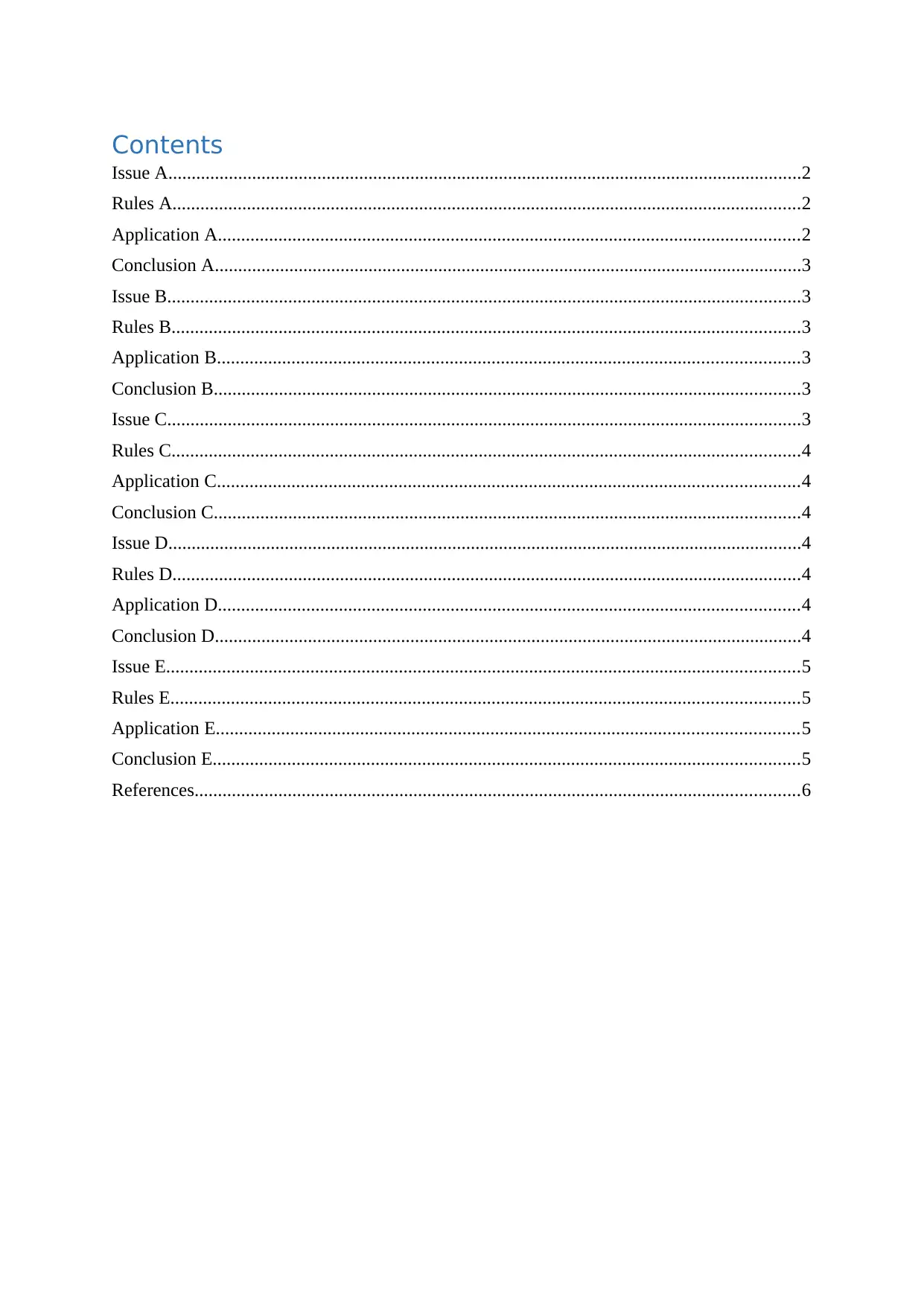
Contents
Issue A........................................................................................................................................2
Rules A.......................................................................................................................................2
Application A.............................................................................................................................2
Conclusion A..............................................................................................................................3
Issue B........................................................................................................................................3
Rules B.......................................................................................................................................3
Application B.............................................................................................................................3
Conclusion B..............................................................................................................................3
Issue C........................................................................................................................................3
Rules C.......................................................................................................................................4
Application C.............................................................................................................................4
Conclusion C..............................................................................................................................4
Issue D........................................................................................................................................4
Rules D.......................................................................................................................................4
Application D.............................................................................................................................4
Conclusion D..............................................................................................................................4
Issue E........................................................................................................................................5
Rules E.......................................................................................................................................5
Application E.............................................................................................................................5
Conclusion E..............................................................................................................................5
References..................................................................................................................................6
Issue A........................................................................................................................................2
Rules A.......................................................................................................................................2
Application A.............................................................................................................................2
Conclusion A..............................................................................................................................3
Issue B........................................................................................................................................3
Rules B.......................................................................................................................................3
Application B.............................................................................................................................3
Conclusion B..............................................................................................................................3
Issue C........................................................................................................................................3
Rules C.......................................................................................................................................4
Application C.............................................................................................................................4
Conclusion C..............................................................................................................................4
Issue D........................................................................................................................................4
Rules D.......................................................................................................................................4
Application D.............................................................................................................................4
Conclusion D..............................................................................................................................4
Issue E........................................................................................................................................5
Rules E.......................................................................................................................................5
Application E.............................................................................................................................5
Conclusion E..............................................................................................................................5
References..................................................................................................................................6
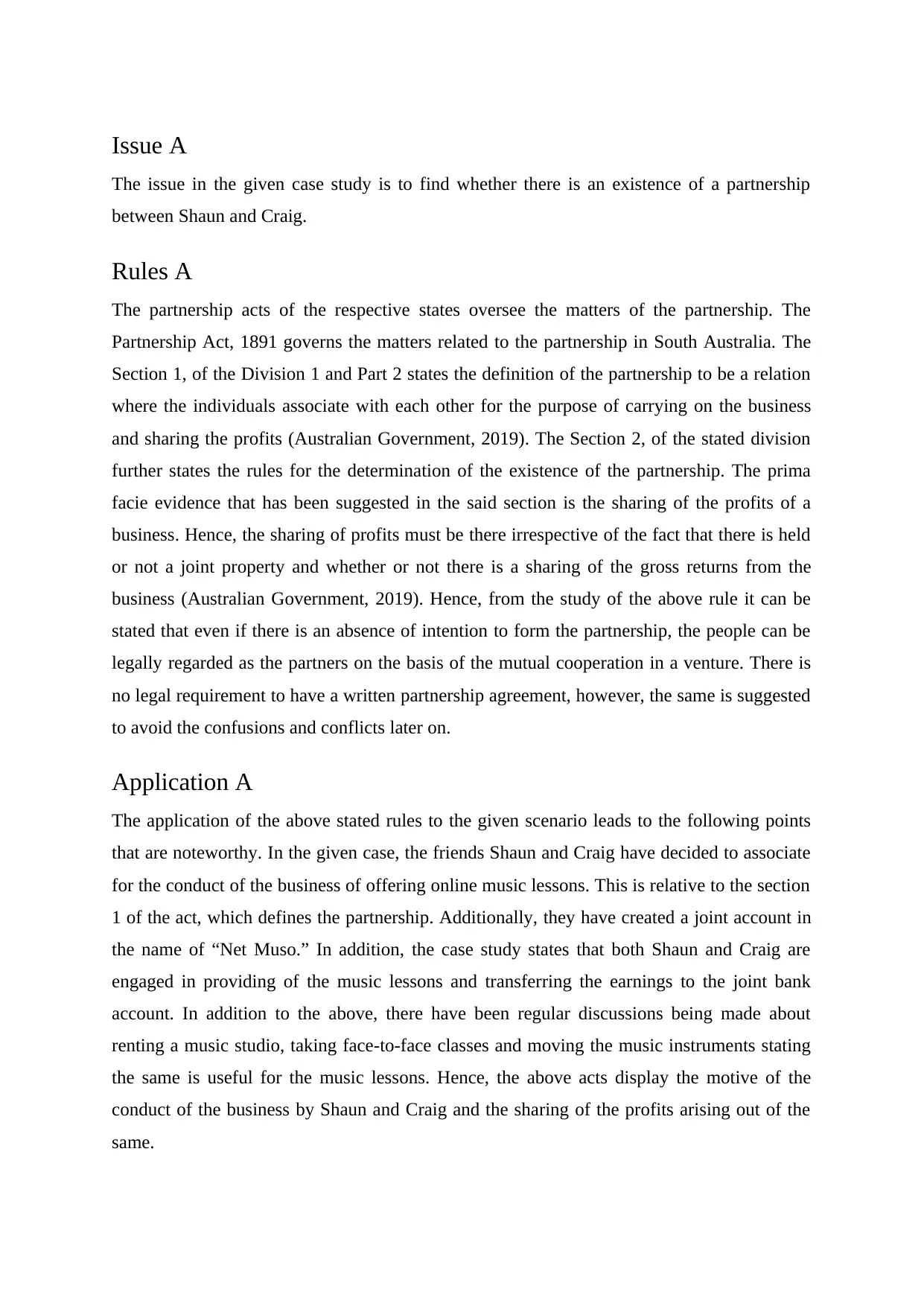
Issue A
The issue in the given case study is to find whether there is an existence of a partnership
between Shaun and Craig.
Rules A
The partnership acts of the respective states oversee the matters of the partnership. The
Partnership Act, 1891 governs the matters related to the partnership in South Australia. The
Section 1, of the Division 1 and Part 2 states the definition of the partnership to be a relation
where the individuals associate with each other for the purpose of carrying on the business
and sharing the profits (Australian Government, 2019). The Section 2, of the stated division
further states the rules for the determination of the existence of the partnership. The prima
facie evidence that has been suggested in the said section is the sharing of the profits of a
business. Hence, the sharing of profits must be there irrespective of the fact that there is held
or not a joint property and whether or not there is a sharing of the gross returns from the
business (Australian Government, 2019). Hence, from the study of the above rule it can be
stated that even if there is an absence of intention to form the partnership, the people can be
legally regarded as the partners on the basis of the mutual cooperation in a venture. There is
no legal requirement to have a written partnership agreement, however, the same is suggested
to avoid the confusions and conflicts later on.
Application A
The application of the above stated rules to the given scenario leads to the following points
that are noteworthy. In the given case, the friends Shaun and Craig have decided to associate
for the conduct of the business of offering online music lessons. This is relative to the section
1 of the act, which defines the partnership. Additionally, they have created a joint account in
the name of “Net Muso.” In addition, the case study states that both Shaun and Craig are
engaged in providing of the music lessons and transferring the earnings to the joint bank
account. In addition to the above, there have been regular discussions being made about
renting a music studio, taking face-to-face classes and moving the music instruments stating
the same is useful for the music lessons. Hence, the above acts display the motive of the
conduct of the business by Shaun and Craig and the sharing of the profits arising out of the
same.
The issue in the given case study is to find whether there is an existence of a partnership
between Shaun and Craig.
Rules A
The partnership acts of the respective states oversee the matters of the partnership. The
Partnership Act, 1891 governs the matters related to the partnership in South Australia. The
Section 1, of the Division 1 and Part 2 states the definition of the partnership to be a relation
where the individuals associate with each other for the purpose of carrying on the business
and sharing the profits (Australian Government, 2019). The Section 2, of the stated division
further states the rules for the determination of the existence of the partnership. The prima
facie evidence that has been suggested in the said section is the sharing of the profits of a
business. Hence, the sharing of profits must be there irrespective of the fact that there is held
or not a joint property and whether or not there is a sharing of the gross returns from the
business (Australian Government, 2019). Hence, from the study of the above rule it can be
stated that even if there is an absence of intention to form the partnership, the people can be
legally regarded as the partners on the basis of the mutual cooperation in a venture. There is
no legal requirement to have a written partnership agreement, however, the same is suggested
to avoid the confusions and conflicts later on.
Application A
The application of the above stated rules to the given scenario leads to the following points
that are noteworthy. In the given case, the friends Shaun and Craig have decided to associate
for the conduct of the business of offering online music lessons. This is relative to the section
1 of the act, which defines the partnership. Additionally, they have created a joint account in
the name of “Net Muso.” In addition, the case study states that both Shaun and Craig are
engaged in providing of the music lessons and transferring the earnings to the joint bank
account. In addition to the above, there have been regular discussions being made about
renting a music studio, taking face-to-face classes and moving the music instruments stating
the same is useful for the music lessons. Hence, the above acts display the motive of the
conduct of the business by Shaun and Craig and the sharing of the profits arising out of the
same.
⊘ This is a preview!⊘
Do you want full access?
Subscribe today to unlock all pages.

Trusted by 1+ million students worldwide
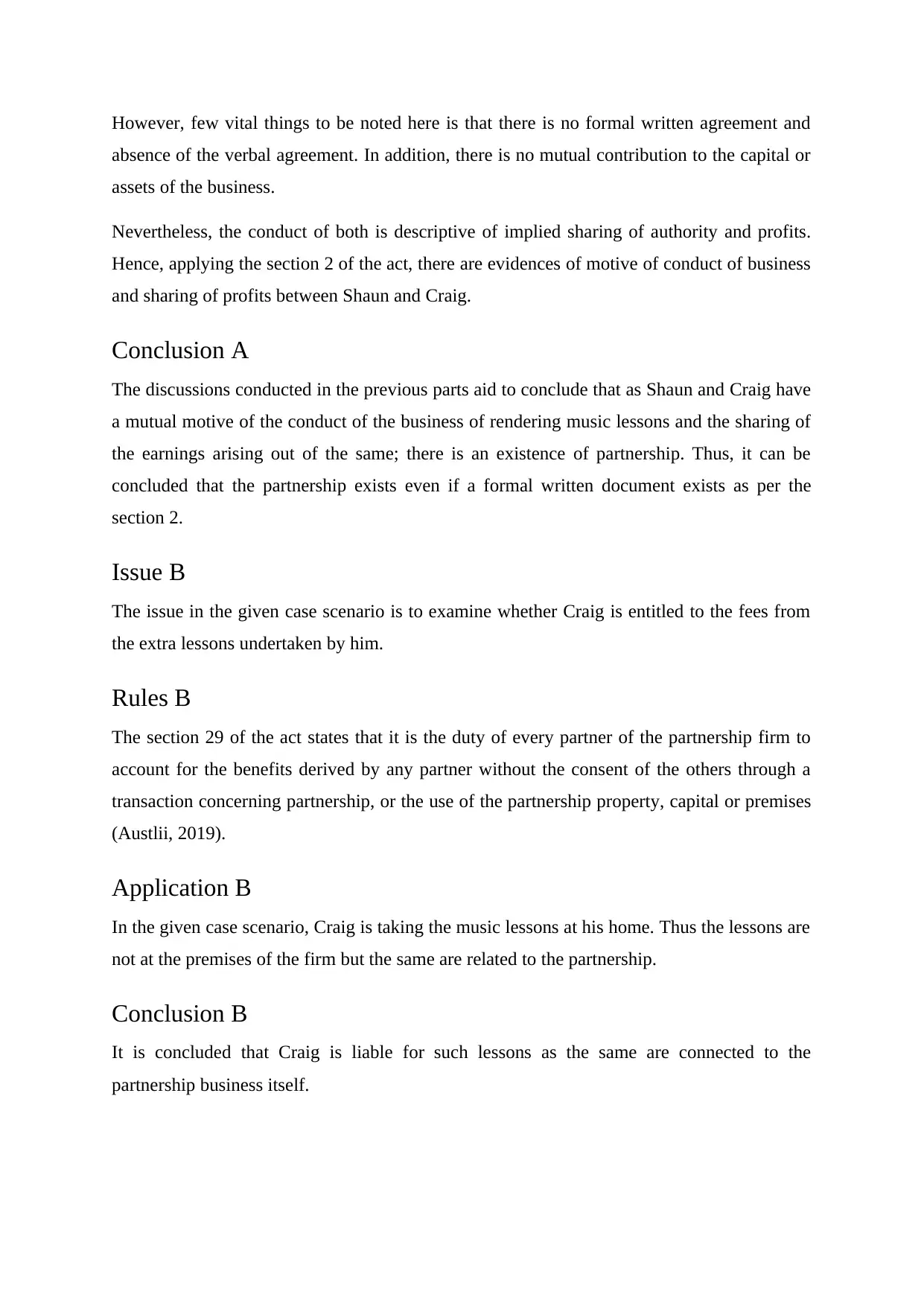
However, few vital things to be noted here is that there is no formal written agreement and
absence of the verbal agreement. In addition, there is no mutual contribution to the capital or
assets of the business.
Nevertheless, the conduct of both is descriptive of implied sharing of authority and profits.
Hence, applying the section 2 of the act, there are evidences of motive of conduct of business
and sharing of profits between Shaun and Craig.
Conclusion A
The discussions conducted in the previous parts aid to conclude that as Shaun and Craig have
a mutual motive of the conduct of the business of rendering music lessons and the sharing of
the earnings arising out of the same; there is an existence of partnership. Thus, it can be
concluded that the partnership exists even if a formal written document exists as per the
section 2.
Issue B
The issue in the given case scenario is to examine whether Craig is entitled to the fees from
the extra lessons undertaken by him.
Rules B
The section 29 of the act states that it is the duty of every partner of the partnership firm to
account for the benefits derived by any partner without the consent of the others through a
transaction concerning partnership, or the use of the partnership property, capital or premises
(Austlii, 2019).
Application B
In the given case scenario, Craig is taking the music lessons at his home. Thus the lessons are
not at the premises of the firm but the same are related to the partnership.
Conclusion B
It is concluded that Craig is liable for such lessons as the same are connected to the
partnership business itself.
absence of the verbal agreement. In addition, there is no mutual contribution to the capital or
assets of the business.
Nevertheless, the conduct of both is descriptive of implied sharing of authority and profits.
Hence, applying the section 2 of the act, there are evidences of motive of conduct of business
and sharing of profits between Shaun and Craig.
Conclusion A
The discussions conducted in the previous parts aid to conclude that as Shaun and Craig have
a mutual motive of the conduct of the business of rendering music lessons and the sharing of
the earnings arising out of the same; there is an existence of partnership. Thus, it can be
concluded that the partnership exists even if a formal written document exists as per the
section 2.
Issue B
The issue in the given case scenario is to examine whether Craig is entitled to the fees from
the extra lessons undertaken by him.
Rules B
The section 29 of the act states that it is the duty of every partner of the partnership firm to
account for the benefits derived by any partner without the consent of the others through a
transaction concerning partnership, or the use of the partnership property, capital or premises
(Austlii, 2019).
Application B
In the given case scenario, Craig is taking the music lessons at his home. Thus the lessons are
not at the premises of the firm but the same are related to the partnership.
Conclusion B
It is concluded that Craig is liable for such lessons as the same are connected to the
partnership business itself.
Paraphrase This Document
Need a fresh take? Get an instant paraphrase of this document with our AI Paraphraser
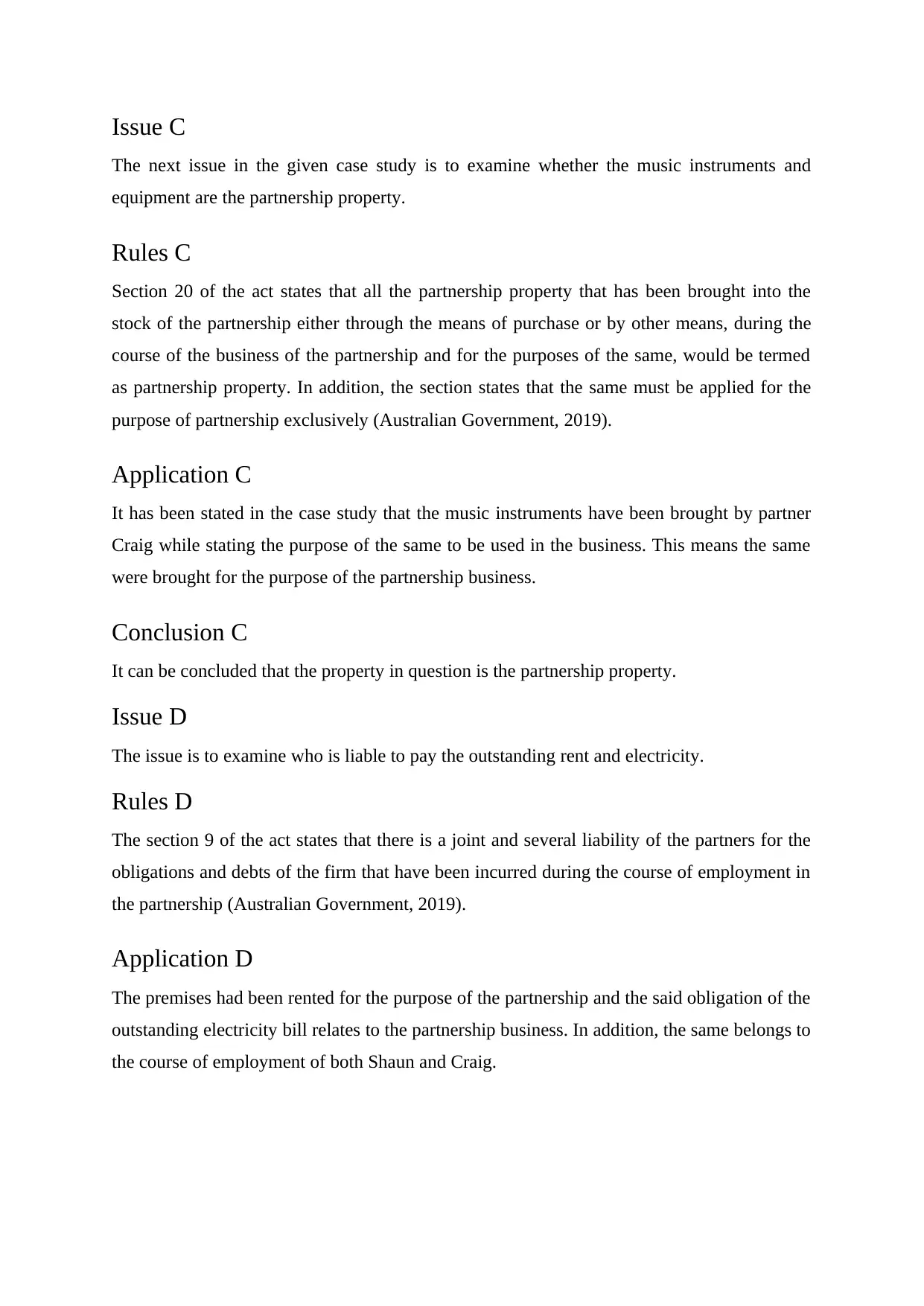
Issue C
The next issue in the given case study is to examine whether the music instruments and
equipment are the partnership property.
Rules C
Section 20 of the act states that all the partnership property that has been brought into the
stock of the partnership either through the means of purchase or by other means, during the
course of the business of the partnership and for the purposes of the same, would be termed
as partnership property. In addition, the section states that the same must be applied for the
purpose of partnership exclusively (Australian Government, 2019).
Application C
It has been stated in the case study that the music instruments have been brought by partner
Craig while stating the purpose of the same to be used in the business. This means the same
were brought for the purpose of the partnership business.
Conclusion C
It can be concluded that the property in question is the partnership property.
Issue D
The issue is to examine who is liable to pay the outstanding rent and electricity.
Rules D
The section 9 of the act states that there is a joint and several liability of the partners for the
obligations and debts of the firm that have been incurred during the course of employment in
the partnership (Australian Government, 2019).
Application D
The premises had been rented for the purpose of the partnership and the said obligation of the
outstanding electricity bill relates to the partnership business. In addition, the same belongs to
the course of employment of both Shaun and Craig.
The next issue in the given case study is to examine whether the music instruments and
equipment are the partnership property.
Rules C
Section 20 of the act states that all the partnership property that has been brought into the
stock of the partnership either through the means of purchase or by other means, during the
course of the business of the partnership and for the purposes of the same, would be termed
as partnership property. In addition, the section states that the same must be applied for the
purpose of partnership exclusively (Australian Government, 2019).
Application C
It has been stated in the case study that the music instruments have been brought by partner
Craig while stating the purpose of the same to be used in the business. This means the same
were brought for the purpose of the partnership business.
Conclusion C
It can be concluded that the property in question is the partnership property.
Issue D
The issue is to examine who is liable to pay the outstanding rent and electricity.
Rules D
The section 9 of the act states that there is a joint and several liability of the partners for the
obligations and debts of the firm that have been incurred during the course of employment in
the partnership (Australian Government, 2019).
Application D
The premises had been rented for the purpose of the partnership and the said obligation of the
outstanding electricity bill relates to the partnership business. In addition, the same belongs to
the course of employment of both Shaun and Craig.
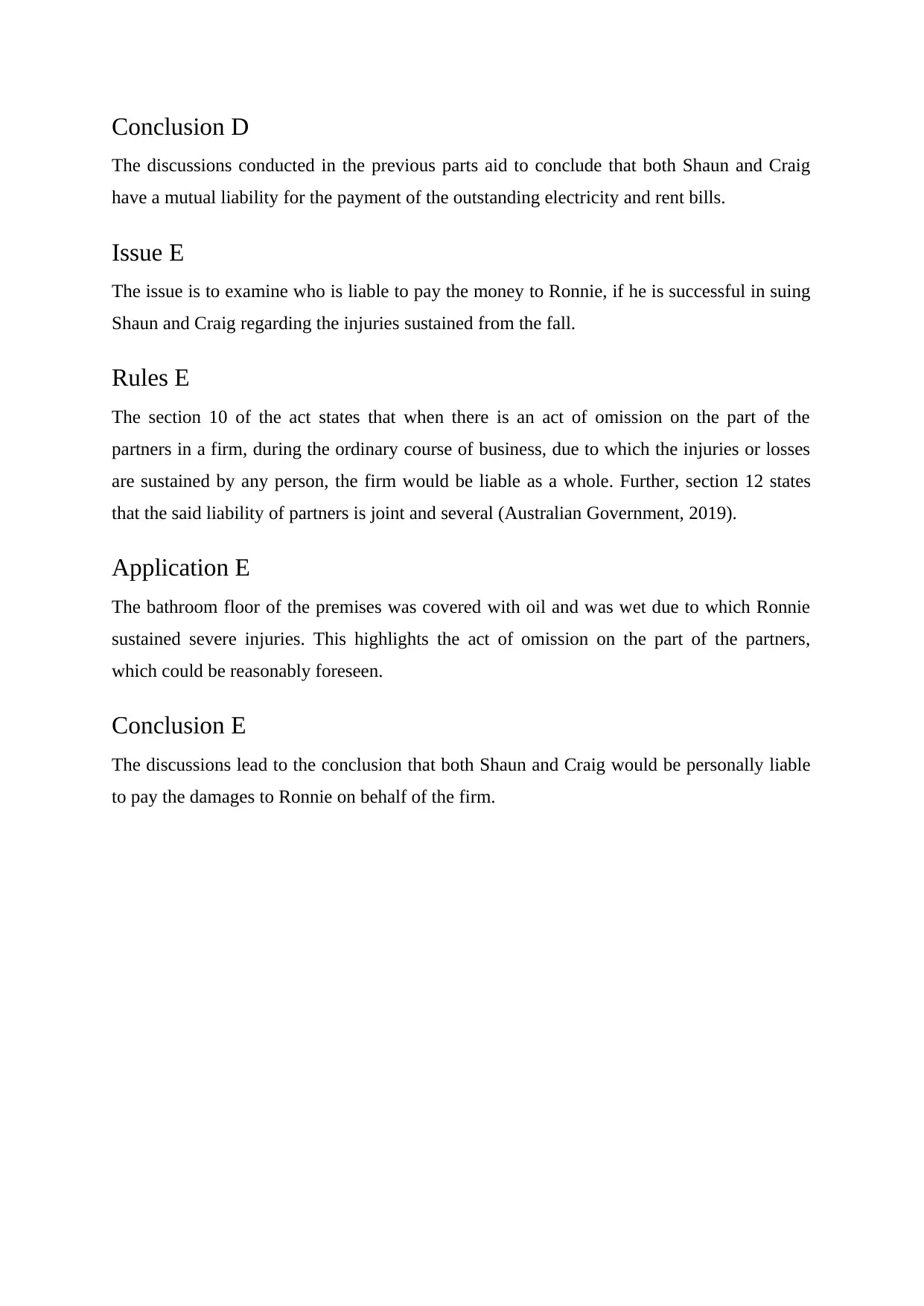
Conclusion D
The discussions conducted in the previous parts aid to conclude that both Shaun and Craig
have a mutual liability for the payment of the outstanding electricity and rent bills.
Issue E
The issue is to examine who is liable to pay the money to Ronnie, if he is successful in suing
Shaun and Craig regarding the injuries sustained from the fall.
Rules E
The section 10 of the act states that when there is an act of omission on the part of the
partners in a firm, during the ordinary course of business, due to which the injuries or losses
are sustained by any person, the firm would be liable as a whole. Further, section 12 states
that the said liability of partners is joint and several (Australian Government, 2019).
Application E
The bathroom floor of the premises was covered with oil and was wet due to which Ronnie
sustained severe injuries. This highlights the act of omission on the part of the partners,
which could be reasonably foreseen.
Conclusion E
The discussions lead to the conclusion that both Shaun and Craig would be personally liable
to pay the damages to Ronnie on behalf of the firm.
The discussions conducted in the previous parts aid to conclude that both Shaun and Craig
have a mutual liability for the payment of the outstanding electricity and rent bills.
Issue E
The issue is to examine who is liable to pay the money to Ronnie, if he is successful in suing
Shaun and Craig regarding the injuries sustained from the fall.
Rules E
The section 10 of the act states that when there is an act of omission on the part of the
partners in a firm, during the ordinary course of business, due to which the injuries or losses
are sustained by any person, the firm would be liable as a whole. Further, section 12 states
that the said liability of partners is joint and several (Australian Government, 2019).
Application E
The bathroom floor of the premises was covered with oil and was wet due to which Ronnie
sustained severe injuries. This highlights the act of omission on the part of the partners,
which could be reasonably foreseen.
Conclusion E
The discussions lead to the conclusion that both Shaun and Craig would be personally liable
to pay the damages to Ronnie on behalf of the firm.
⊘ This is a preview!⊘
Do you want full access?
Subscribe today to unlock all pages.

Trusted by 1+ million students worldwide
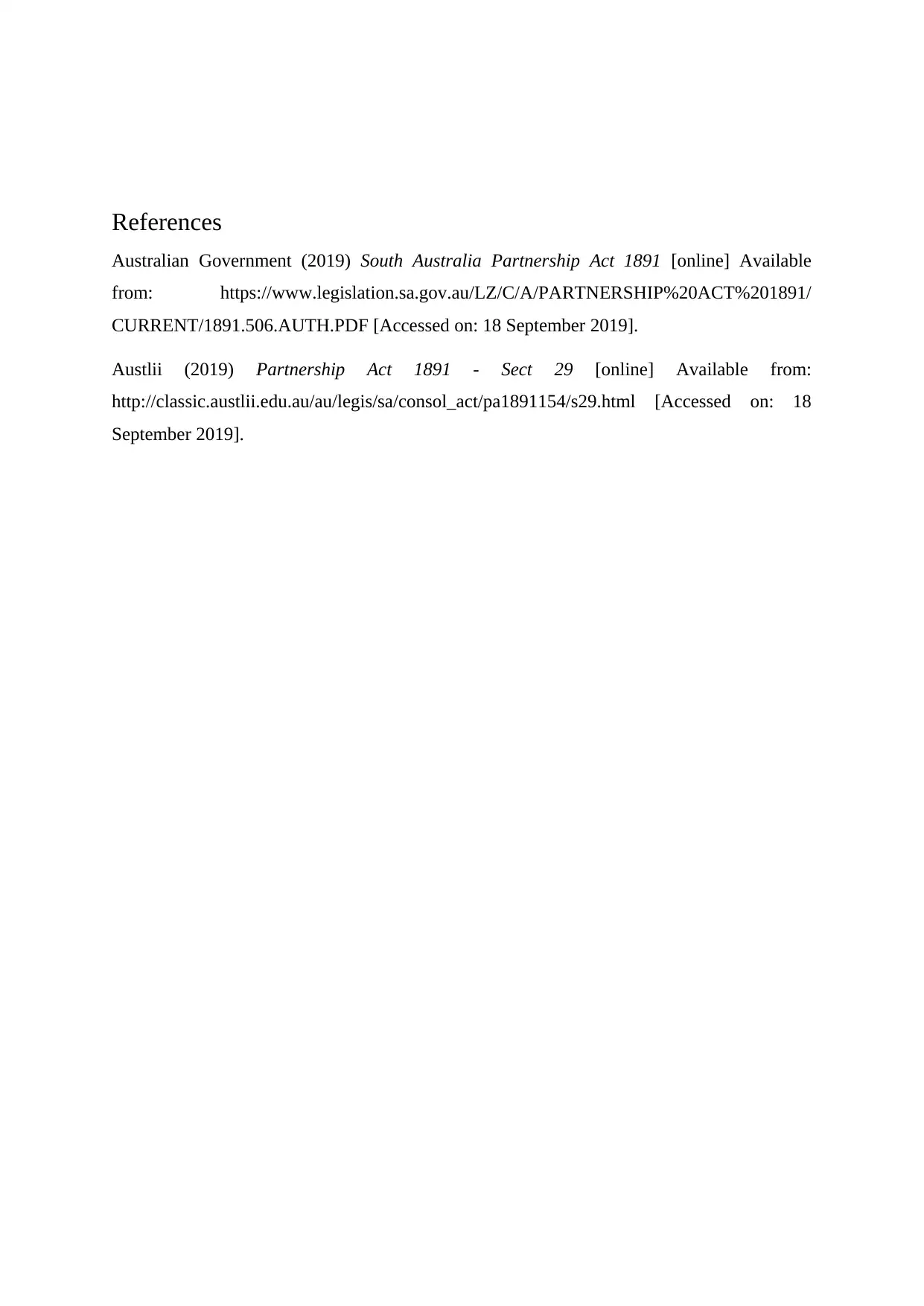
References
Australian Government (2019) South Australia Partnership Act 1891 [online] Available
from: https://www.legislation.sa.gov.au/LZ/C/A/PARTNERSHIP%20ACT%201891/
CURRENT/1891.506.AUTH.PDF [Accessed on: 18 September 2019].
Austlii (2019) Partnership Act 1891 - Sect 29 [online] Available from:
http://classic.austlii.edu.au/au/legis/sa/consol_act/pa1891154/s29.html [Accessed on: 18
September 2019].
Australian Government (2019) South Australia Partnership Act 1891 [online] Available
from: https://www.legislation.sa.gov.au/LZ/C/A/PARTNERSHIP%20ACT%201891/
CURRENT/1891.506.AUTH.PDF [Accessed on: 18 September 2019].
Austlii (2019) Partnership Act 1891 - Sect 29 [online] Available from:
http://classic.austlii.edu.au/au/legis/sa/consol_act/pa1891154/s29.html [Accessed on: 18
September 2019].
1 out of 7
Related Documents
Your All-in-One AI-Powered Toolkit for Academic Success.
+13062052269
info@desklib.com
Available 24*7 on WhatsApp / Email
![[object Object]](/_next/static/media/star-bottom.7253800d.svg)
Unlock your academic potential
Copyright © 2020–2025 A2Z Services. All Rights Reserved. Developed and managed by ZUCOL.





